Illuminating Your Space Without Draining Your Wallet
Looking for quick ways to save with energy efficient outdoor lighting? Here’s what you need to know:
- LED lights use up to 75% less energy and last 25 times longer than incandescent bulbs
- Solar-powered fixtures can reduce outdoor lighting electricity use to zero
- Motion sensors and timers can cut energy usage by activating lights only when needed
- ENERGY STAR certified fixtures use 90% less energy than traditional models
Energy efficient outdoor lighting isn’t just a trend—it’s a smart investment that improves your property while keeping utility bills manageable. Whether you’re lighting up your garden pathways, securing your property, or creating ambiance on your patio, today’s energy-saving options deliver impressive illumination without the shocking electric bills of traditional lighting systems.
The perfect outdoor lighting balances functionality, aesthetics, and efficiency. Modern LED and solar technologies have revolutionized what’s possible, offering solutions that consume a fraction of the electricity while providing superior light quality and durability in Central Indiana’s variable climate conditions.
Many homeowners don’t realize that outdoor lighting typically accounts for a significant portion of their property’s energy consumption. With traditional incandescent bulbs, leaving exterior lights on for security or ambiance can quickly add up on monthly utility bills. The good news? Switching to energy-efficient alternatives can reduce this lighting energy use by 70-90% while extending replacement intervals from months to years or even decades.
I’m Clay Hamilton, President of Grounded Solutions, bringing over two decades of hands-on expertise in electrical systems with specialized experience implementing energy efficient outdoor lighting solutions throughout Central Indiana.
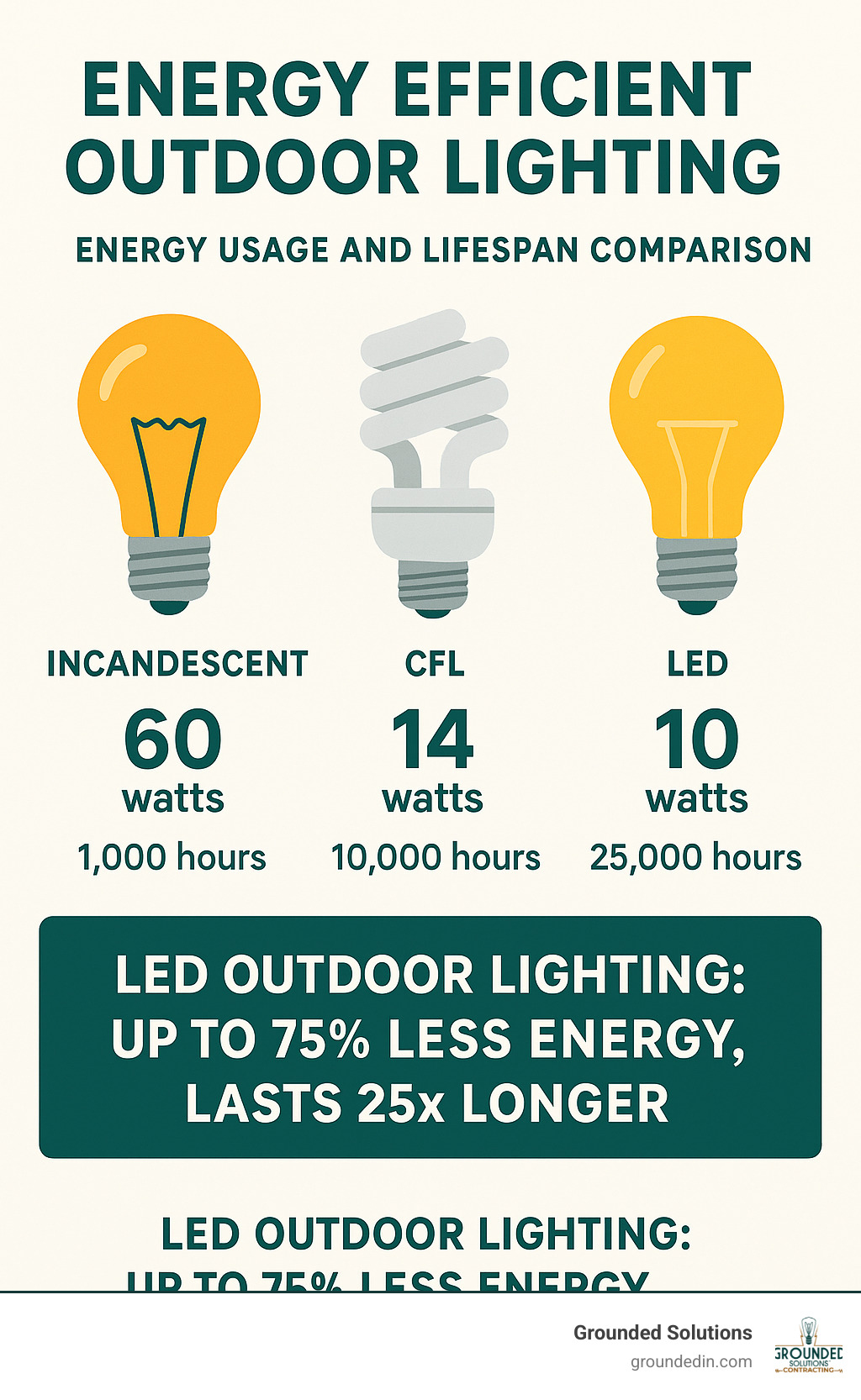
Why Energy-Efficient Outdoor Lighting Matters
There’s something magical about the right outdoor lighting. It transforms your property, creates ambiance, and provides security—but traditional lighting can take a serious toll on both your wallet and the environment. That’s where energy efficient outdoor lighting makes all the difference.
When our team at Grounded Solutions installs these systems for homeowners across Indianapolis and central Indiana, we see how they benefit families in multiple ways. It’s not just about saving money (though that’s certainly a nice perk).
The environmental impact is substantial. According to ENERGY STAR, if every American home replaced just one regular light bulb with an energy-efficient alternative, we’d save enough electricity to light 3 million homes for a year. That’s the equivalent of taking 800,000 cars’ worth of greenhouse gas emissions off the road!
Beyond the eco-friendly aspects, modern lighting simply performs better. I’ve watched homeowners’ faces light up (pun intended) when they see how LED flood lights cast crisp, directional illumination that deters potential intruders while using just a fraction of the electricity. Solar pathway lights create welcoming entrances without adding a penny to your electric bill.
As one of our Carmel clients told us after their upgrade: “We’re actually using more lights around our property now, but our electric bill went down by nearly $40 a month. Plus, the quality of light is so much better—no more yellow glow, just clean, bright illumination exactly where we need it.”
For more technical insights, scientific research on outdoor solar lighting from the Department of Energy confirms these impressive efficiency gains.
Key Benefits at a Glance
When you make the switch to energy efficient outdoor lighting, you’re investing in benefits that last for years to come. Most homeowners are amazed by the dramatically longer lifespan of modern fixtures—quality LEDs can function for 50,000 to 100,000 hours, which translates to over 20 years of normal use. This means fewer bulb changes, which is especially valuable for those hard-to-reach fixtures mounted high on exterior walls or trees.
The lower wattage consumption is remarkable too. LEDs use up to 75% less energy than incandescent bulbs while producing the same or better light output. This efficiency translates to reduced maintenance costs and significant savings over time.
I’ve also noticed that energy-efficient outdoor lighting has become an improved property value factor as more buyers prioritize eco-friendly features. The better light quality with superior color rendering makes your landscaping look more vibrant and natural. Plus, the compact nature of LED technology allows for greater design flexibility with innovative fixture shapes that weren’t possible with traditional bulbs.
A Noblesville homeowner summed it up perfectly after we completed their installation: “After Grounded Solutions installed our new LED landscape lighting, not only did our home look like something from a magazine at night, but we calculated we’ll save over $2,000 in energy and replacement costs over the next decade.”
Energy Efficient Outdoor Lighting vs. Traditional Fixtures
The numbers tell a compelling story when comparing lighting technologies:
| Feature | LED | CFL | Incandescent |
|---|---|---|---|
| Energy Usage | 7-15 watts | 13-25 watts | 60-100 watts |
| Lumens per Watt | 70-100 | 55-70 | 15-17 |
| Average Lifespan | 50,000+ hours | 8,000 hours | 1,200 hours |
| Durability | High (solid state) | Medium (fragile tube) | Low (fragile filament) |
| Cold Weather Performance | Excellent | Poor | Good |
| Heat Emission | Minimal | Moderate | High |
| Contains Mercury | No | Yes | No |
| Instant On | Yes | No (warm-up time) | Yes |
These differences become even more meaningful in practical terms. A 25-watt LED outdoor floodlight produces approximately 2,650 lumens and uses up to 90% less energy than equivalent incandescent bulbs. This means you could power ten LED floodlights for the same energy cost as a single traditional incandescent flood—illuminating your entire property for the same cost as lighting just one area the old way.
In central Indiana’s variable climate, the excellent cold weather performance of LEDs is particularly valuable. Unlike CFLs that struggle to start up in freezing temperatures, LEDs maintain consistent performance year-round, ensuring your property stays well-lit through those chilly winter months.
Choosing Your Light Source: LED, Solar, Low-Voltage & Hybrids
When it comes to energy efficient outdoor lighting, you’re not stuck with just one option. Central Indiana homeowners have several excellent technologies to choose from, each with unique advantages for our region’s distinct seasonal patterns and your specific property needs.
LED Options for Every Zone
Remember those hot, energy-hogging outdoor lights that needed replacing every season? LED technology has changed everything. These remarkable solid-state lights deliver stunning illumination while sipping electricity compared to their predecessors.
Flood Lights have been completely transformed by LED technology. Just last month, we installed a 25-watt LED flood system for a Fishers family that replaced their power-hungry 150-watt halogens. Not only did they get the same brightness, but their energy usage dropped by over 80%—and they couldn’t be happier about it.
Path Lights with LED technology use just 3-7 watts compared to the 15-20 watts their traditional counterparts demand. Beyond energy savings, they run much cooler, making them safer around mulch and decorative landscaping materials that could potentially ignite with hotter fixtures.
Wall Packs mounted on exterior walls are another perfect application for LED technology. The uniform light distribution eliminates those annoying hot spots you get with conventional lighting, creating a more pleasing and effective security perimeter.
When selecting LED fixtures, consider the color temperature carefully. Warm white (2700K-3000K) creates that cozy, inviting glow perfect for entertaining spaces like patios and decks. Neutral white (4000K) works beautifully as all-purpose lighting, while cooler daylight tones (5000K-6000K) excel in security applications where maximum visibility matters most.
As one Westfield client told me after we completed their upgrade, “I worried LEDs would give that harsh, bluish light, but the warm white LEDs Grounded Solutions installed give my garden the same amber glow I loved from my old lights—without the constant bulb changes and high electric bills.”
Learn more about our LED lighting upgrade services
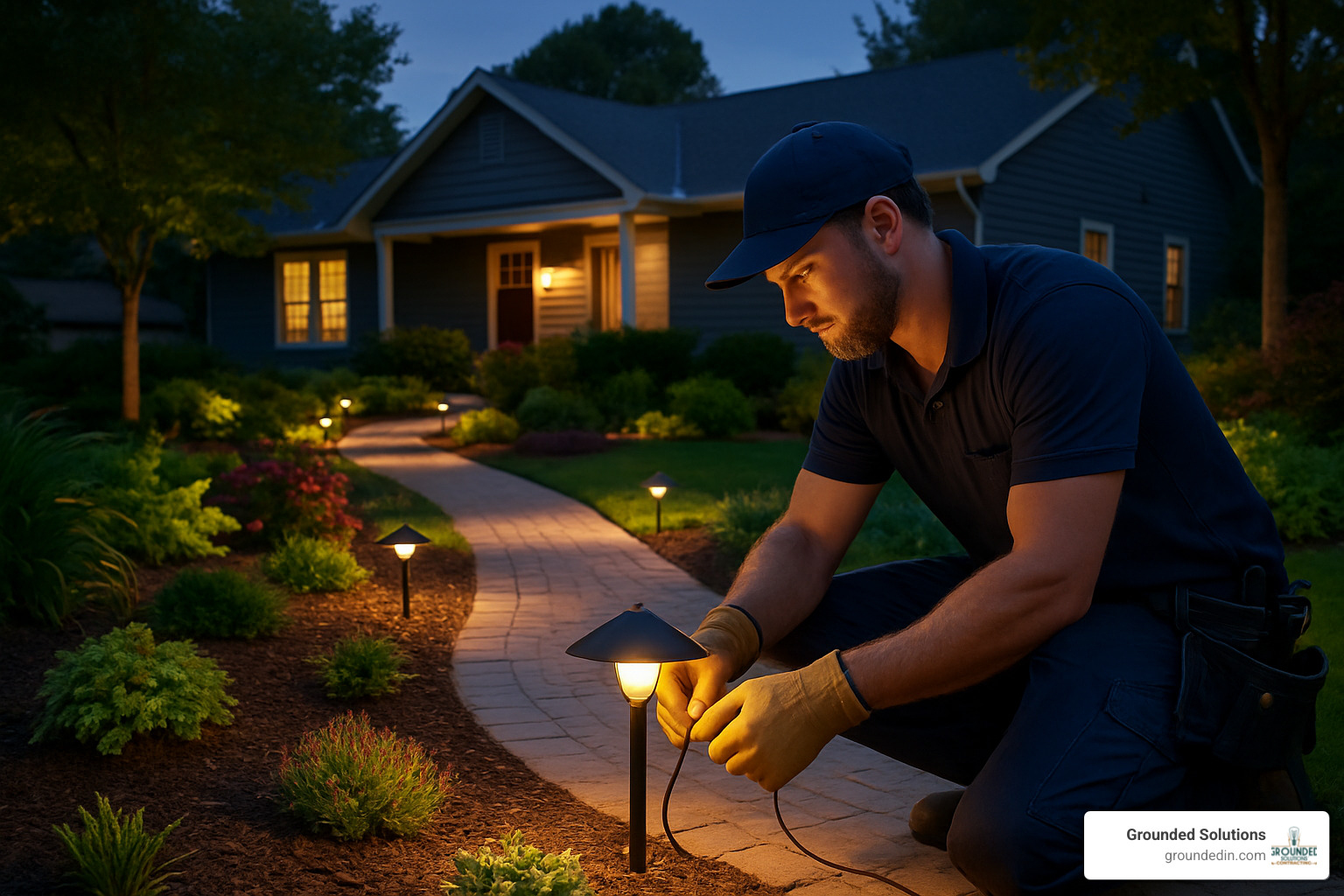
Solar-Powered Fixtures—Pros, Cons & Best Uses
Solar lighting has matured dramatically in recent years. The flimsy, dim solar lights of the past have given way to robust fixtures that can actually deliver meaningful illumination—with zero electricity costs.
The advantages are compelling: no operational energy costs, simple installation without complex wiring, and completely automated operation from dusk till dawn. For remote corners of your property where running electrical lines would be prohibitively expensive, solar offers an neat solution.
That said, solar comes with considerations specific to our Central Indiana climate. Winter performance can drop by 30-50% due to our shorter, often cloudy days. Panel placement becomes critical—we typically position them facing south to capture maximum sunlight during our shorter winter days.
I remember helping a Greenwood family tackle lighting for their incredibly long driveway. “Running electrical would have cost thousands,” they explained. We selected high-quality solar fixtures with separate, positionable panels that we could mount for optimal sun exposure. Even during January’s shortest days, those lights reliably illuminate their property every evening.
Solar shines brightest (pun intended) for pathway and garden accent lighting, dock or pond illumination, temporary event lighting, and those distant areas of large properties where traditional wiring simply isn’t practical.
When to Go Low-Voltage
Low-voltage systems, typically running at 12 volts, offer a sweet spot between standard 120V systems and solar options. They’ve become the gold standard for professional landscape lighting because they balance safety, flexibility, and energy efficiency.
The safety factor alone makes low-voltage worth considering—especially for families with children or pets. These systems run at voltages low enough to eliminate most shock hazards during installation or maintenance. The fixtures themselves tend to be smaller and more discreet, allowing your landscape—not the lighting hardware—to remain the star of the show.
Every low-voltage system requires a transformer to convert your home’s standard 120V power to 12V. This transformer becomes the heart of your system and can include convenient features like timers and photocells for automated operation. When we design systems, we carefully calculate the proper transformer size based on the total wattage of all fixtures, with room for future expansion.
While big-box stores offer DIY low-voltage kits from $15-$100, I’ve seen too many disappointed homeowners struggling with dim lights and reliability issues. A Zionsville client called us after trying this route: “I spent a weekend installing a store-bought kit and ended up with lights that barely glowed and constantly failed.” Our professional-grade system has worked flawlessly for years, with fixtures that withstand Indiana’s freeze-thaw cycles and properly sized wiring that delivers consistent brightness to every fixture.
Even low-voltage systems must adhere to electrical codes. Our licensed electricians ensure all installations meet or exceed local requirements, particularly regarding transformer installation and proper wire burial depth—giving you peace of mind along with beautiful illumination.
Looking to explore which lighting technology makes the most sense for your property? Give us a call—we’ll help you steer the options and find the perfect energy efficient outdoor lighting solution for your specific needs.
Designing for Purpose: Security, Aesthetics & Utility with Energy Efficient Outdoor Lighting
When we approach energy efficient outdoor lighting projects for our Central Indiana clients, we always start with a simple question: “What do you want your lights to accomplish?” The answer shapes everything that follows.
The magic happens when you understand that outdoor lighting isn’t one-size-fits-all. At Grounded Solutions, we design in thoughtful layers—each serving a distinct purpose. Think of your property’s lighting as having different “zones” of functionality: security to protect your home, task lighting for activities like grilling or entertaining, accent lighting to showcase your landscaping investments, and ambient lighting to set the right mood for outdoor living.
This layered approach not only creates a more beautiful result but also prevents one of the biggest energy-wasters we see: over-lighting the entire property with the same intensity. I’ve seen too many homes where every corner blazes with the same bright light, using far more energy than needed while creating an uncomfortable glare.
Security Without Light Pollution
Good security lighting doesn’t mean turning your yard into a stadium at night. In fact, some of the worst security lighting I’ve seen creates harsh shadows that actually give potential intruders more places to hide.
We recommend shielded LED fixtures that direct light precisely where needed. These fixtures prevent light from spilling upward (where it’s wasted) or sideways (where it bothers neighbors). For most residential security applications, fixtures producing between 700-1,300 lumens provide ample illumination without creating that harsh “prison yard” effect.
The real energy-saving secret is combining motion sensors with photocells. This way, your security lights only activate when someone is present—and only when it’s actually dark outside. One Avon homeowner told me, “My old floodlights ran all night, every night. Now they only come on when needed, and my electricity bill shows the difference!”
Proper positioning makes all the difference too. We focus on eliminating potential hiding spots rather than creating contrasting bright and dark areas. And we typically recommend warmer color temperatures (3000K-4000K) that provide excellent visibility without the harsh, bluish glare that cooler LEDs can produce.
Learn more about the benefits of professional landscape lighting
Show-Stopping Landscape Accents
Here’s where lighting becomes an art form. With today’s energy efficient outdoor lighting options, we can create breathtaking effects while using remarkably little electricity.
Uplighting is one of my favorite techniques—placing fixtures at ground level to illuminate trees, architectural details, or garden elements from below. A modern 7-watt LED uplight creates the same dramatic effect as the old 50-watt halogens, but uses just a fraction of the energy.
Downlighting (sometimes called “moonlighting”) involves placing fixtures in trees or on structures to cast gentle light downward. When done right, it creates the romantic effect of natural moonlight filtering through branches. I still remember a Carmel client’s reaction when we first turned on their new system: “It looks like we captured moonlight in our backyard!”
Modern LED systems now offer color tuning capabilities too, allowing you to adjust the color temperature or even introduce subtle colored lighting for holidays or special occasions without changing fixtures.
The beam spread of each fixture is another important consideration. Narrow beams (15-30 degrees) create dramatic spotlighting effects, while wider spreads (60+ degrees) provide gentler washes of light. Choosing the right beam spread helps us minimize the number of fixtures needed, saving both energy and installation costs.
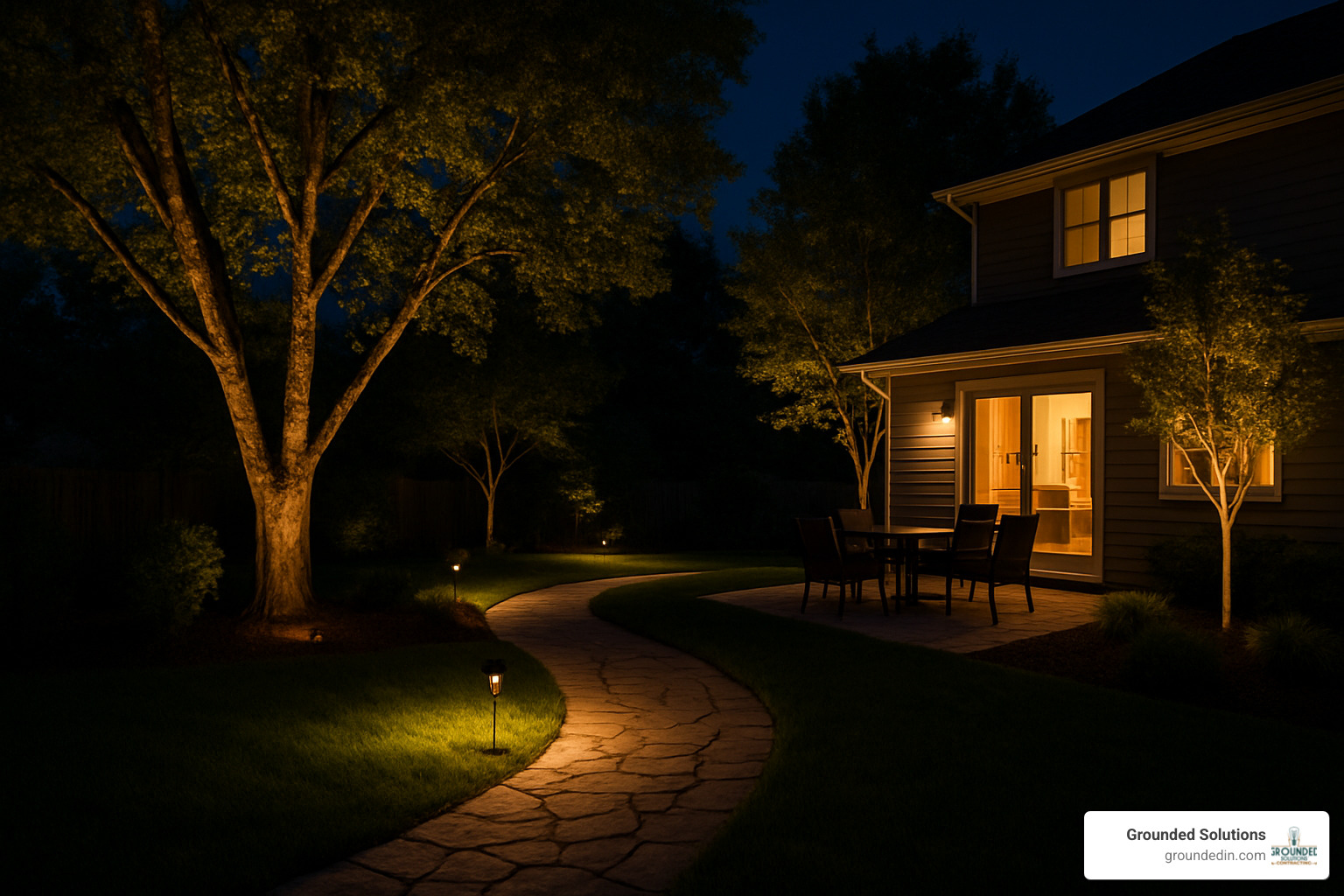
Utility & Pathway Safety
Safety lighting doesn’t have to be boring or energy-hungry. Some of the most neat lighting solutions we install are also the most practical.
Step lights recessed into stair risers or walls use just 2-5 watts per fixture but make a huge difference in preventing trips and falls. I often recommend installing these at alternating steps rather than every single step—this maintains safety while minimizing energy use.
Bollards are those short, post-like fixtures that provide downward illumination for pathways. The older versions used 25-40 watts each, but the modern LED bollards we install use just 5-10 watts while providing better light quality.
For pathway lighting, we favor low-glare path LEDs that direct light downward onto walking surfaces rather than outward into people’s eyes. Not only is this more energy-efficient (since the light goes exactly where needed), but it also creates a more comfortable experience for everyone using the path.
For commercial properties and homes where accessibility matters, we always consider ADA requirements. Proper pathway lighting without glare or extreme contrast helps ensure safe navigation for people with visual impairments. As one Brownsburg client told us after we installed recessed step lighting for her elderly mother: “These lights barely register on our electric bill, but they’ve given Mom her confidence back for using the patio steps at night.”
The best energy efficient outdoor lighting designs balance functionality, beauty, and efficiency. When done right, you’ll wonder how you ever lived without it—and your utility bill will make you wonder why you didn’t switch sooner.
Installing & Maintaining Efficient Fixtures the Right Way
When it comes to energy efficient outdoor lighting, proper installation and ongoing maintenance aren’t just details—they’re essential for maximizing both energy savings and fixture lifespan. Even the most advanced LED system won’t deliver on its promises if it’s incorrectly installed or neglected over time.
Here in Central Indiana, outdoor lighting faces unique challenges from our dramatic seasonal shifts. From summer thunderstorms to winter’s freeze-thaw cycles, your lighting system needs to stand up to whatever Mother Nature throws its way. That’s why all outdoor electrical work must strictly comply with National Electrical Code (NEC) requirements and local regulations.
Before you begin any installation, make sure your fixtures carry the right credentials. Look for the UL or ETL marks that indicate the product has been tested and approved for outdoor use. Pay close attention to IP (Ingress Protection) ratings too—you’ll want at least IP65 for exposed locations and IP67 or higher for anything installed at ground level where water might pool.
Weatherproof junction boxes aren’t optional in our climate—they’re absolutely essential. The same goes for GFCI protection on all outdoor circuits and proper grounding throughout your system. These safety features protect both your home and your family.
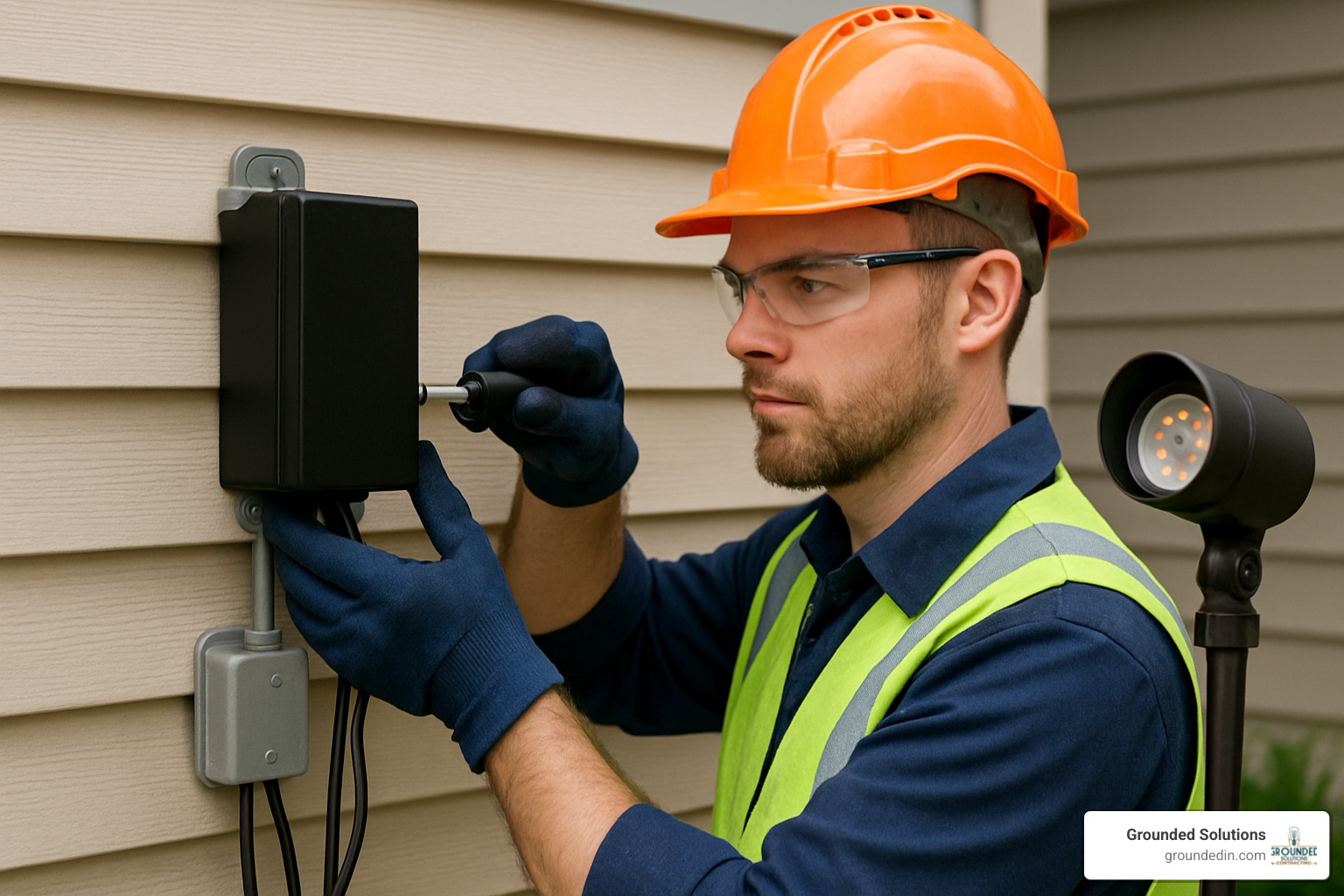
Best Practices for DIYers
If you’re the hands-on type who enjoys tackling home projects yourself, certain aspects of outdoor lighting can be DIY-friendly—particularly low-voltage systems. Just remember these critical guidelines to ensure your system works properly and safely.
For low-voltage installations, always bury your cables at least 6 inches deep to protect them from lawn equipment and curious animals. Use only direct burial-rated cable that’s designed to withstand soil moisture and temperature fluctuations. I always recommend leaving a bit of extra cable at each fixture location—this small step makes future adjustments much easier if your landscaping changes.
Your transformer should always be installed on a GFCI-protected circuit, and every connection in your system deserves a high-quality waterproof wire connector. One tip I share with all our clients: create a simple map of your cable runs and keep it with your home documentation. You’ll thank yourself years later when you need to troubleshoot or expand your system.
Solar lighting installations have their own considerations. Position is everything—your solar panels need maximum sun exposure, which typically means facing south in our hemisphere. Develop a habit of periodically cleaning the panels, especially after fall leaf drop or spring pollen season. A quick wipe with a soft cloth can significantly improve charging efficiency.
“I installed my own solar path lights,” one Avon homeowner told me, “but called Grounded Solutions for advice when they weren’t lasting through the night. Their suggestion to reposition my panels to a sunnier location and adjust the angle made all the difference—my lights now stay bright even during winter’s shorter days.”
For any system with timers or controls, remember to update your settings seasonally as daylight hours change. Astronomical timers that automatically adjust to sunset and sunrise times are worth the slight additional investment, especially if you travel frequently.
Learn more about installing outdoor lighting in Central Indiana
When to Call a Licensed Electrician
While there’s satisfaction in completing DIY projects, some aspects of outdoor lighting installation simply require professional expertise. Knowing when to call in a licensed electrician not only ensures your system works properly but can prevent dangerous situations.
Adding new circuits to your electrical panel is never a DIY project. This work involves your home’s main electrical supply and presents serious shock hazards even for experienced hobbyists. The same applies to installing line-voltage (120V) outdoor lighting systems, which must meet strict code requirements to be safe in wet locations.
Mounting fixtures in challenging locations like rooflines or tall trees is another situation where professional help makes sense. Our technicians arrive with the proper safety equipment and experience to handle these installations efficiently and safely.
Load calculations—determining if your existing circuits can handle additional lighting—require professional knowledge. An overloaded circuit isn’t just an inconvenience; it’s a fire hazard waiting to happen.
Many Central Indiana communities require permits and inspections for electrical work, even for what seems like simple outdoor lighting. Our licensed electricians at Grounded Solutions handle all permitting requirements and ensure your installation passes inspection the first time.
A client in Fishers recently shared, “I initially thought installing outdoor lighting would be a simple weekend project. But when I realized it required running a new circuit from my panel, I called Grounded Solutions. Their electrician completed in a few hours what would have taken me days, and I have peace of mind knowing it was done safely and to code.”
Whether you’re considering a DIY approach or professional installation, proper maintenance is key to long-term performance. Clean fixtures regularly, check connections annually, and replace failed components promptly to keep your energy efficient outdoor lighting system performing at its best for years to come.
Smart Controls & Automation for Extra Savings
Taking your energy efficient outdoor lighting to the next level doesn’t just mean installing better bulbs—it’s about making your entire system smarter. Modern automation technology transforms static lighting systems into responsive networks that deliver light only when and where it’s needed.
As we’ve seen with many of our Indianapolis area clients, adding smart controls can reduce outdoor lighting energy consumption by an additional 30-50% beyond the savings from efficient fixtures alone. These systems essentially give your lights a brain, allowing them to make intelligent decisions without any effort on your part.
“I was amazed at how much difference the smart controls made,” shared one of our Noblesville homeowners. “My outdoor lights now automatically adjust to seasonal changes, turn on only when needed, and I can control everything from my phone. My electricity bill dropped even more than when we first switched to LEDs.”
Combining Sensors with Energy Efficient Outdoor Lighting
The real magic happens when sensors and energy efficient outdoor lighting work together. This partnership creates a responsive system that maximizes both security and savings:
Motion sensors have come a long way from the jumpy, oversensitive models of the past. Today’s advanced sensors can distinguish between a neighbor’s cat and an actual person approaching your property. When paired with LED flood lights, they create a security system that remains dormant until needed, slashing energy usage by 70-90% compared to lights left on continuously.
Photocells ensure your lights never waste energy during daylight hours. These small light-detecting components automatically adjust to seasonal changes, meaning your dusk-to-dawn lighting truly operates from dusk to dawn—not based on a timer that needs constant adjustment as days grow longer or shorter.
Many of our Carmel and Fishers clients opt for combination control systems that incorporate both motion detection and photocell technology. These intelligent systems ensure outdoor lights operate only after dark and only when activity is detected—the ultimate in efficiency.
For areas like front porches or garages, the distinction between occupancy sensing and vacancy sensing becomes important. While occupancy sensors automatically activate lights when they detect presence, vacancy sensors require manual activation but turn off automatically after a period of inactivity. This subtle difference can provide significant additional savings in areas where lights aren’t always necessary when someone is present.
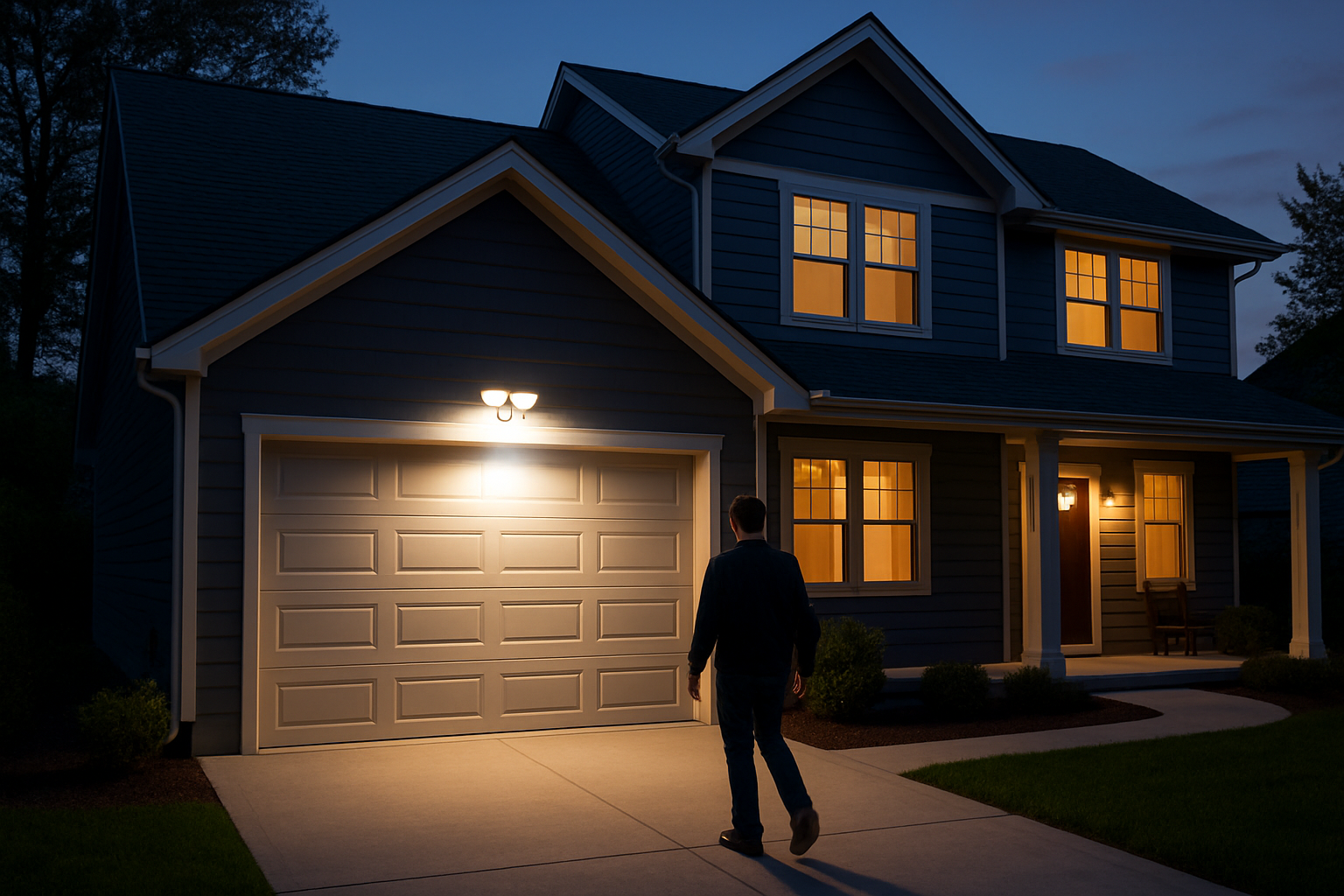
Data-Driven Optimization
The most advanced outdoor lighting systems don’t just operate independently—they collect data that helps you understand exactly how and when your lights are being used:
Runtime tracking provides insights into exactly how long each fixture operates. This information often reveals surprising patterns that can lead to further optimization. One Greenwood business owner finded their parking lot lights were running an average of 14 hours per night when they only needed illumination for about 8 hours during business operations.
Seasonal adjustment capabilities have become increasingly sophisticated. Rather than simply turning on at sunset, smart systems can adjust brightness levels throughout the night, perhaps running at 100% during early evening hours when outdoor activity is likely, then dimming to 50% during overnight hours for security while maximizing energy savings.
Cloud dashboards have transformed how we interact with outdoor lighting. Through simple smartphone apps, you can monitor and adjust your entire property’s lighting from anywhere in the world. This remote access isn’t just convenient—it provides peace of mind and allows for immediate adjustments when weather or activity patterns change.
For our more data-minded clients, energy use reporting offers concrete numbers on electricity consumption and savings. These reports help quantify the return on investment from lighting upgrades and identify opportunities for further optimization.
One commercial property manager in Carmel worked with our team to implement a comprehensive smart control system that reduced their outdoor lighting energy consumption by 62%. Beyond the energy savings, they particularly valued the automated alerts that notified security personnel when motion was detected in specific zones after hours.
Smart controls represent the perfect complement to efficient fixtures—while better bulbs and fixtures reduce the energy used when lights are on, intelligent controls ensure they’re only on when truly needed.
Learn more about the latest in lighting efficiency and controls
Avoiding Pitfalls: Common Mistakes & Light-Pollution Etiquette
I’ve seen it time and again in my years working throughout Central Indiana – homeowners excited about their new outdoor lighting only to be disappointed months later. Not because energy efficient outdoor lighting isn’t amazing (it absolutely is!), but because of a few avoidable mistakes that can turn your illumination dreams into costly headaches.
Over-lighting is probably the number one issue we encounter. It’s tempting to think “more light equals better visibility,” but excessive brightness actually creates harsh glare that can make your property less secure. Your eyes can’t adjust properly between extremely bright and dark areas, creating blind spots that defeat the purpose of security lighting. Plus, all that unnecessary brightness wastes electricity – exactly what you’re trying to avoid!
“We had a client in Carmel who initially installed twelve 100-watt floodlights around their property,” I remember with a chuckle. “Their home looked like a prison yard at night, their neighbors were complaining, and their electric bill jumped by $80 monthly. We replaced everything with strategically placed 20-watt LED fixtures that actually improved visibility while cutting their lighting energy use by nearly 90%.”
Choosing the wrong color temperature is another common misstep. Those cool white (5000K+) LEDs might seem like a bargain because they produce more lumens per watt, but they create that harsh, institutional bluish light that makes your home feel unwelcoming. Most residential properties look far better with warmer light in the 2700K-3500K range, which creates a more natural, inviting atmosphere while still providing excellent visibility.
Poor fixture placement causes more neighbor disputes than you might imagine. Light trespass – when your lighting spills onto neighboring properties – isn’t just annoying; it’s a form of pollution that disrupts sleep patterns and wildlife. Properly aimed and shielded fixtures direct light exactly where you need it without bothering anyone else.
As one Indianapolis homeowner finded: “We initially bought the cheapest solar lights we could find, but they barely lasted through one winter. Grounded Solutions helped us select quality fixtures that have performed flawlessly for years, actually saving us money in the long run.”
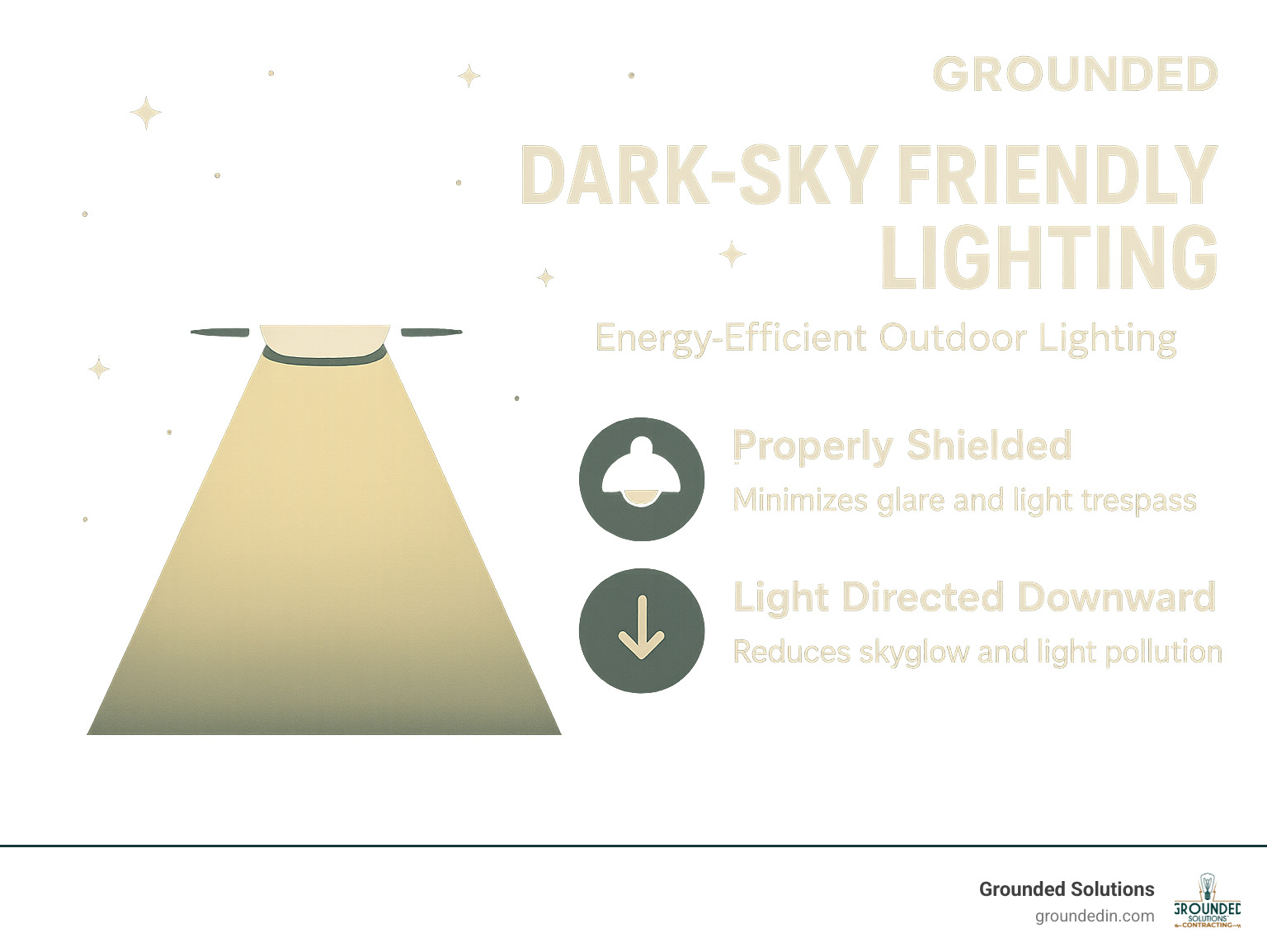
Checklist Before You Buy
Before you click “purchase” on those outdoor fixtures, take a moment to run through this quality checklist. It might save you significant frustration and expense down the road:
Look for that ENERGY STAR certification – it’s your guarantee that the fixture meets strict efficiency guidelines established by the EPA. For outdoor use, UL wet-location listing or equivalent certification is non-negotiable for safety.
Don’t overlook the IP rating – in Indiana’s varied weather, you’ll want IP65 at minimum for most applications, and IP67 for anything installed at ground level where water might pool. The warranty length tells you volumes about manufacturer confidence – quality LED fixtures typically carry 5+ year warranties because manufacturers know they’ll last.
Pay attention to actual lumen output rather than just wattage – this tells you how bright the light will actually be. Choose color temperature thoughtfully based on your home’s style and the mood you want to create (those warm 2700K-4000K tones work best for most homes).
If you’re planning to create different lighting scenes, verify dimming capability and compatibility with your control system. And for environmentally conscious homeowners, look for dark-sky compliance that minimizes upward light pollution.
“I spent hours researching fixtures online,” shared a Noblesville client, “but the five minutes I spent reviewing Grounded Solutions’ checklist saved me from making an expensive mistake on outdoor fixtures that wouldn’t have stood up to our Indiana winters.”
Check our guide to light bulb types and choices
Disposal & Environmental Impact
The environmental benefits of energy efficient outdoor lighting extend well beyond your utility bills, but proper disposal practices are essential to maximize these advantages.
Those LED fixtures contain electronic components that should never end up in landfills. Many hardware stores throughout Indianapolis and surrounding communities offer specific LED recycling programs – we’re happy to point you toward the closest option.
Solar lights present their own challenge with battery disposal. Those rechargeable batteries contain materials that can harm soil and water if improperly discarded. Throughout Central Indiana, you’ll find battery collection points at many retail locations and community recycling centers.
Something few people consider is the embodied energy – the total energy used to manufacture and transport products to your home. While efficient fixtures definitely save energy during operation, choosing locally sourced products when possible and maintaining fixtures for maximum lifespan helps reduce the overall environmental footprint of your lighting system.
One particularly environmentally conscious Greenwood client shared: “When we upgraded our outdoor lighting, Grounded Solutions not only installed our new LED system but also properly recycled all our old fixtures and bulbs. It was a completely guilt-free improvement.”
The most sustainable fixture is often one you don’t need to replace for decades – another reason quality matters so much in outdoor lighting. With proper selection and installation, your energy efficient outdoor lighting system should provide beautiful, effective illumination with minimal environmental impact for many years to come.
Frequently Asked Questions about Energy Efficient Outdoor Lighting
How much can I really save by switching to LEDs outdoors?
The savings from making the switch to LED outdoor lighting are genuinely impressive. Let me share what we typically see with our Central Indiana customers.
Consider a typical home with five exterior lights using traditional 60-watt incandescent bulbs that run for 8 hours each night. These fixtures alone consume about 876 kilowatt-hours annually. By converting to equivalent 9-watt LED bulbs, that consumption drops dramatically to just 131 kilowatt-hours—an 85% reduction in energy use!
I recently worked with a family in Noblesville who replaced twelve 50-watt halogen landscape lights (totaling 600 watts) with 7-watt LED fixtures (just 84 watts total). Running these lights 5 hours nightly, their annual landscape lighting energy usage plummeted from 1,095 kWh to only 153 kWh. This translated to approximately $94 in savings each year at current Indiana electricity rates.
What really impressed them, though, was the long-term math. Since their new LED fixtures will last 20+ years compared to the annual bulb replacements their halogen system required, they’ll save over $2,500 during the lifetime of their system. As they told me, “It’s like getting free lighting for the last 15 years!”
Do solar lights work in Indiana winters?
Yes, quality solar lights absolutely can work during Indiana winters, though with some seasonal adjustments. The shorter days and increased cloud cover typically reduce winter performance by about 30-50% compared to summer months.
For homeowners wanting year-round solar lighting in our climate, I recommend these practical strategies:
Select solar fixtures with larger panels and higher-capacity batteries for critical areas. The extra collection and storage capacity makes a significant difference during those short winter days. Position your panels with maximum southern exposure to capture whatever sunlight is available. Remember to periodically brush snow and debris from the panels—even a partial covering can dramatically reduce charging efficiency.
For areas where consistent lighting is essential, consider hybrid systems with battery backup. These provide the best of both worlds—energy-free operation most of the time with reliable backup when needed.
One of our Brownsburg clients shared her experience after our installation: “Our solar pathway lights from Grounded Solutions run about 12 hours in summer and 5-6 hours in winter, which still covers the evening hours when we need them most. We’re thrilled not to have an electric bill for our beautiful pathway lighting!”
What certifications should I look for on outdoor fixtures?
Selecting properly certified fixtures is crucial for safety, performance, and longevity, especially given Central Indiana’s variable climate. Here are the key certifications I always recommend to our clients:
UL or ETL listing specifically for outdoor use is essential—look for “wet location” or “damp location” ratings depending on exposure. This certification ensures the fixture has been tested for safety in outdoor conditions.
ENERGY STAR certification guarantees the fixture meets strict efficiency guidelines established by the EPA. These products typically use 90% less energy than traditional models.
IP65 rating minimum for basic weather exposure, with higher ratings (IP67 or IP68) for fixtures that will be at ground level or in areas with standing water. The first digit indicates dust protection, while the second addresses water resistance.
For commercial applications, look for DLC (Design Lights Consortium) listing, which often qualifies fixtures for utility rebates while ensuring commercial-grade performance.
If you’re concerned about light pollution affecting wildlife or stargazing, seek fixtures with a Dark Sky Compliant designation.
Beyond these certifications, always check the operating temperature range. Quality outdoor fixtures should handle Indiana’s full climate spectrum—from below 0°F during our harshest winter nights to above 90°F in the peak of summer.
As one of our Carmel clients finded after a disappointing experience with budget fixtures: “I learned the hard way that certifications matter. After replacing three sets of inexpensive outdoor lights in two years, I called Grounded Solutions. The properly certified fixtures they installed have withstood everything from ice storms to summer heat waves without a hiccup.”
Conclusion
Implementing energy efficient outdoor lighting around your Central Indiana home delivers far more than just lower utility bills. It creates a safer environment, highlights your property’s architectural features, and represents a meaningful step toward environmental sustainability. Today’s technologies—from LEDs to solar fixtures and smart controls—offer remarkable illumination quality while using just a fraction of the energy traditional systems consume.
Throughout this guide, we’ve seen that successful outdoor lighting doesn’t happen by accident. It requires thoughtful design, quality components, and proper installation techniques. Whether you’re handling simple projects yourself or bringing in professionals for more complex systems, understanding these fundamental principles helps you make smarter decisions for your home.
Here at Grounded Solutions, we’ve helped countless homeowners across Indianapolis, Carmel, Fishers, Noblesville and surrounding communities transform their outdoor spaces with efficient, beautiful lighting systems built to withstand Indiana’s challenging weather conditions. As your neighbors and local licensed electrical contractors, we bring specialized knowledge about regional requirements, code compliance, and proven solutions specifically suited to Central Indiana properties.
I’ve personally seen the delight on homeowners’ faces when they first see their property illuminated with professionally designed lighting that costs pennies a day to operate. There’s something magical about creating both beauty and efficiency in a single project—it’s why I love what we do.
Ready to brighten your outdoor spaces without inflating your energy bills? Our team of friendly, licensed electricians would be happy to evaluate your current setup, recommend energy-saving improvements, and implement solutions custom specifically to your property’s unique characteristics and your personal budget. From straightforward fixture replacements to comprehensive landscape lighting designs with automated controls, we provide the expertise and craftsmanship to get it right the first time.
Contact us today to learn more about our electrical services and repair options and take the first step toward outdoor lighting that’s as energy-efficient as it is beautiful. Your more efficient, more attractive property is just a conversation away.
